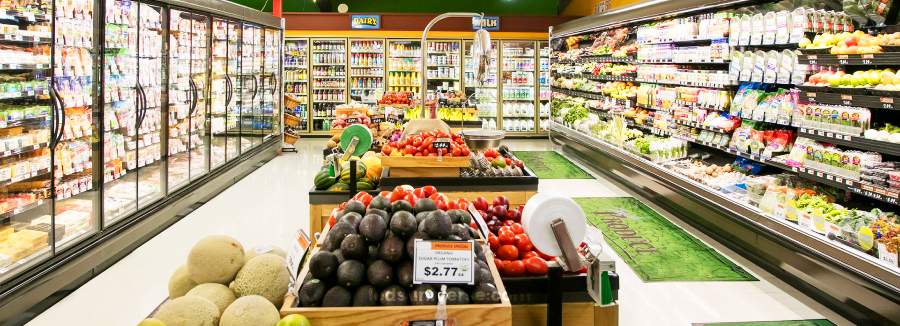When you step into a supermarket, the sheer volume of products and the meticulous arrangement of aisles can be overwhelming, but there’s an unsung hero behind this visual feast: lighting. Far from being just a practical necessity, the way a supermarket is illuminated transforms the entire shopping experience. Imagine a store where every shelf is bathed in perfect light, highlighting the freshness of produce and the appeal of baked goods.
Supermarkets use different lighting techniques to create a welcoming atmosphere and to highlight various products. Lighting is more than just illumination; it influences the way customers perceive the quality and freshness of items and can significantly affect their purchasing decisions.
Reach out for free lighting consultation
Table of Contents
ToggleLighting in a supermarket goes beyond just visibility. It plays a significant role in drawing customers in, showcasing products, and ultimately influencing purchasing behavior. Imagine walking past two supermarkets, one brightly lit and inviting, and the other dim and unwelcoming. The human tendency is to gravitate toward the better-lit environment, where everything appears more appealing and accessible. The right lighting creates a visual allure that not only attracts customers but also makes products more enticing, enhancing their perceived quality.

Lighting design in a supermarket must balance functionality and aesthetics. Different sections of a supermarket have distinct lighting needs. For instance, the grocery aisle requires bright, uniform lighting to make packaged goods easy to read, while the fresh produce section benefits from warmer lighting to make fruits and vegetables appear more vibrant and fresh.
One of the most critical design considerations is ensuring even lighting across aisles. Inadequate lighting can lead to dark corners and shadows, making products harder to see and less likely to be purchased. The goal is to create a welcoming ambiance that encourages customers to linger and explore. Designers often use a mix of ambient and task lighting to achieve this. Ambient lighting provides general illumination, while task lighting highlights specific areas like promotional displays or checkout counters. This balance ensures that customers can easily navigate the store while being subtly drawn to featured products.
The choice of color temperature and Color Rendering Index (CRI) is essential in supermarket lighting. A high CRI ensures that products appear as true-to-life as possible, while the right color temperature creates a comfortable shopping atmosphere. Warm lighting is typically used in areas where natural, fresh products like fruits and vegetables are displayed, while cooler tones are reserved for packaged goods or frozen items. Proper color rendition can enhance the appearance of food, making it look more appealing and fresh, which in turn drives sales.

With the advent of smart lighting, supermarkets can now optimize energy efficiency and lighting quality. Smart lighting solutions enable the integration of sensors that adjust the brightness based on the time of day or the number of customers in the store. These systems can automatically dim or brighten lights depending on the activity levels in specific areas, ensuring energy is used efficiently.
Motion-activated lights in less-trafficked areas such as stockrooms or empty aisles can greatly reduce energy consumption. For instance, lights in refrigerated sections can be dimmed when no one is nearby, brightening up only when a customer approaches. Additionally, automated systems can adjust lighting levels based on the availability of natural daylight. These energy-saving measures not only reduce costs but also contribute to a more eco-friendly operation.
Another benefit of smart lighting systems is the ability to schedule dimming and lighting adjustments throughout the day. For example, supermarkets can brighten the store during peak hours when more customers are shopping and dim the lights during slower periods. This can be tied to store opening and closing times, ensuring that lighting is always optimized for customer traffic while conserving energy.
Maintaining lighting systems in a supermarket is crucial for ensuring that the shopping environment remains inviting and well-lit. Poorly maintained lighting can lead to flickering bulbs, dark spots, or inconsistent brightness, which can negatively impact customer experience.
Regular inspection of lighting fixtures is essential to ensure they are functioning correctly. Dust and debris can accumulate on light fixtures, reducing their brightness and efficiency. Cleaning the fixtures regularly can help maintain the light output and ensure that products are always displayed in their best light. Inspections should also check for any flickering or burnt-out bulbs that need to be replaced promptly.
Supermarkets should also consider replacing outdated lighting systems with more energy-efficient alternatives such as LEDs. LED lighting not only lasts longer but also consumes less energy compared to traditional lighting solutions. Upgrading to LEDs can result in significant cost savings over time and provide better, more consistent illumination.

Regular inspections and upgrades of the supermarket lighting system are essential for maintaining a high-quality shopping experience. Over time, lighting technology evolves, and supermarkets must keep up with these changes to ensure they provide the best possible environment for their customers.
Early detection of issues such as flickering lights, dim areas, or malfunctioning fixtures can prevent bigger problems down the line. Regular inspections can help identify areas where lighting is no longer adequate, allowing supermarkets to make necessary adjustments before it negatively impacts sales. In addition, timely upgrades to newer lighting technologies can improve energy efficiency and reduce maintenance costs.
Lighting technology is constantly evolving, and supermarkets should consider upgrading their systems regularly. Transitioning to energy-efficient lighting options such as LEDs not only reduces energy consumption but also enhances the quality of lighting. LEDs offer better brightness, color accuracy, and longevity, which can help reduce operational costs in the long run.
Lighting significantly influences the overall customer experience in a supermarket. A well-lit environment can create a sense of warmth and comfort, making shoppers feel more at ease as they navigate the store. This positive atmosphere encourages customers to spend more time browsing, which can lead to increased purchases. For instance, lighting that highlights fresh produce or bakery items can enhance their appeal, making them look more appetizing and high-quality. The strategic use of lighting to create focal points in the store can also guide customers to specific sections, promoting impulse buys and special promotions. By carefully considering how lighting affects the shopping experience, supermarkets can design environments that are both functional and engaging, ultimately driving higher customer satisfaction and loyalty.
Seasonal and promotional events offer unique opportunities for supermarkets to leverage lighting to create special shopping experiences. During holidays or sales events, supermarkets can use themed lighting to enhance the atmosphere and draw attention to specific products or areas. For example, warm, festive lights can be used during the holiday season to create a cozy and celebratory ambiance, while bright, vibrant colors can highlight seasonal promotions and clearance sales. Adapting lighting to fit these events not only helps to create a more engaging shopping environment but also aligns with marketing strategies to boost sales. Implementing dynamic lighting that changes with the seasons or special promotions can keep the store experience fresh and exciting, encouraging customers to visit more frequently and take advantage of the special offers.
From enhancing the visual appeal of products to improving energy efficiency, lighting plays a pivotal role in the overall success of a supermarket. With smart lighting solutions, routine maintenance, and regular upgrades, supermarkets can ensure their lighting systems remain efficient and effective. The key is to strike the perfect balance between functionality, aesthetics, and energy efficiency, creating a pleasant shopping experience that encourages customers to return time and again.
By integrating these design considerations, smart technologies, and maintenance practices, supermarkets can ensure their lighting not only enhances the customer experience but also contributes to operational savings.